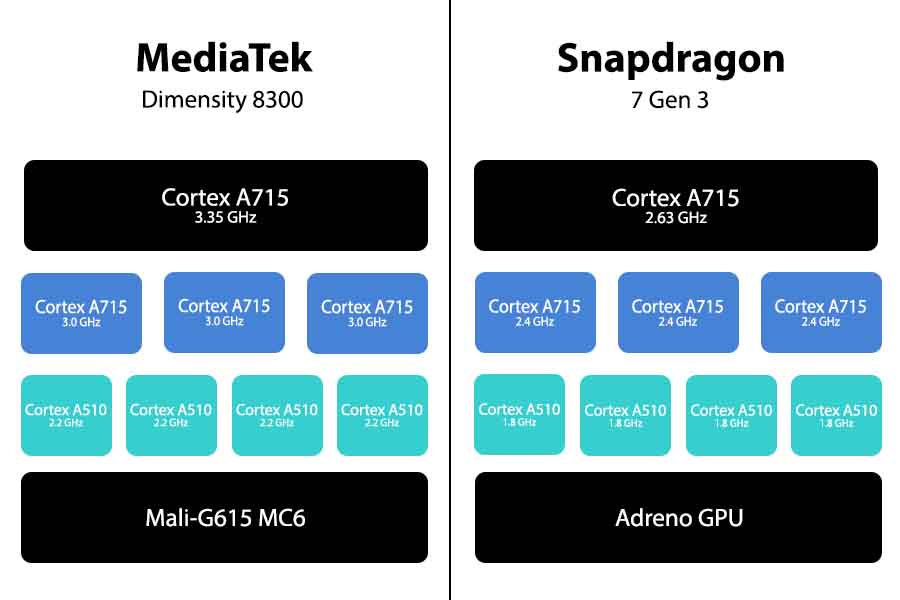
The fight between the two big mobile chip companies, Snapdragon and MediaTek, isn’t settling anytime soon. While MediaTek provides better affordable options, Snapdragon thrives in the high-end segment. Let’s see who wins this fight for the mid-range section in the upcoming year, the new MediaTek Dimensity 8300 versus the Snapdragon 7 Gen 3.
MediaTek Dimensity 8300 vs. Snapdragon 7 Gen 3 Overview:
One thing to take clear note of is that the Snapdragon 7 Gen 3 is a successor to Gen 1 rather than a direct upgrade to any of the Gen 2 chipsets (7s or 7+).
CPU
Starting with the core architectures, we get to see an upgrade from both sides. The Dimensity 8300 adopts the ArmV9 CPU architecture, boasting 20% faster CPU performance and up to 30% more efficiency in power usage compared to its forerunner. On the other hand, the Snapdragon 7 Gen 3 sees a 15% improvement over its first generation.

On paper, the performance side is weak for the Snapdragon 7 Gen 3, as the Dimensity 8300 has a way higher clock speed than the Qualcomm chip. For reference, the Gen 3 chip has all the same cores as the Dimensity 8300, but with a much lower clock frequency, as you can see from the table below.
| MediaTek Dimensity 8300 | Snapdragon 7 Gen 3 | |
| Node | 4 nm TSMC | 4 nm TSMC |
| Prime core | 1x Cortex-A715 @ 3.35 GHz | 1x Cortex-A715 @ 2.63 GHz |
| Big cores | 3x Cortex-A715 @ 3.0 GHz | 3x Cortex-A715 @ 2.4 GHz |
| Little cores | 4x Cortex-A510 @ 2.2 GHz | 4x Cortex-A510 @ 1.8 GHz |
Power usage might be the one thing both chips are equally good at, thanks to TSMC’s 4nm process.
- Read more:
GPU and AI Showdown
Even though we don’t have exact numbers to compare the GPUs of the Dimensity 8300 and SD 7 Gen 3, the former appears to have the upper hand. Building on the lead of the Dimensity 8200, MediaTek claims a 60% boost to the GPU, surpassing Qualcomm’s 50% boost from SD 7 Gen 1.

In the realm of AI processing, it is not sure how these two pair against each other. The Dimensity 8300 introduces the APU 780, supporting Generative AI with stable diffusion and LLM with up to 10 billion parameters. In contrast, the Snapdragon 7 Gen 3 relies on its Hexagon NPU, boasting 60% faster performance per watt than its predecessor.
Hardware supports
The Snapdragon chip settles for 6.4 Gbps LPDDR5 RAM, compared to the faster 8.5 Gbps LPDDR5x on Dimensity’s new SoC. Both are neck-to-neck on displays, as the former can utilize WFHD+ at 168 Hz & WQHD+ at 120 Hz, while the latter can get FHD+ at 180 Hz & WQHD+ at 120 Hz. Further, the Snapdragon 7 Gen 3 can refresh at 60 Hz for internal or external 4K displays.
On the ISP side, Qualcomm’s Spectra tops out at 200 MP, while the Imagiq 980 for Dimensity 8300 supports a 320 MP sensor. Both can record 4K HDR videos at 60 Hz and support sub-6GHz. But Dimensity 8300 edges ahead with a 5.17 Gbps download speed. Both have WiFi 6E; however, Dimensity has the latest version of Bluetooth, i.e., 5.4.
Here’s the table:
| MediaTek Dimensity 8300 | Snapdragon 7 Gen 3 | |
| RAM | LPDDR5x (8.5Gbps) | LPDDR5 (6.4Gbps) |
| ROM | UFS 4.0 | UFS 3.1 |
| Display | FHD+ @180 Hz WQHD+ @120Hz |
WFHD+ @168 Hz WQHD+ @120Hz 4K @60Hz |
| ISP | 320MP lens Video: 4K @60fps |
200MP lens Video: 4K @60fps |
| Connectivity | WiFi 6E Bluetooth 5.4 |
WiFi 6E Bluetooth 5.3 |
| Network | 5.17Gbps (sub-6GHz) Dual-mode 5G |
5Gbps |
MediaTek Dimensity 8300 vs. Snapdragon 7 Gen 3: Conclusion
MediaTek’s Dimensity 8300 takes the win by miles, no doubt. Frankly speaking, this is not a fair fight for the Snapdragon 7 Gen 3. Maybe Qualcomm will release a 7+ Gen 3 to compete with this chip, or they might continue their weird naming scheme with a direct 7+ Gen 4 in the near future. Until then, Dimensity 8300 will be the king of midrange chips!
- Meanwhile, check out our Snapdragon 8 Gen 2 vs. A16 Bionic vs. Dimensity 9200 video.







![Best Gaming Laptops in Nepal Under Rs. 250,000 (रु 2.5 Lakhs) [2025] Best Gaming Laptops Under 2.5 lakhs in Nepal [Feb 2025 Update]](https://cdn.gadgetbytenepal.com/wp-content/uploads/2025/02/Best-Gaming-Laptops-Under-2.5-lakhs-in-Nepal-Feb-2025-Update.jpg)
![Best Gaming Laptops in Nepal Under Rs. 120,000 (रु 1.2 Lakhs) [2025] Best Budget Gaming Laptops Under Rs 120000 in Nepal 2025 Update](https://cdn.gadgetbytenepal.com/wp-content/uploads/2025/05/Best-Budget-Gaming-Laptops-Under-Rs-120000-in-Nepal-2024-Update.jpg)
![Best Laptops Under Rs. 80,000 in Nepal [2025] Best Laptops Under 80,000 in Nepal March 2025 Update](https://cdn.gadgetbytenepal.com/wp-content/uploads/2025/03/Best-Laptops-Under-80000-in-Nepal-March-2025-Update.jpg)
![Best Laptops Under Rs. 70,000 in Nepal [2025] Best Laptops Under 70,000 in Nepal March 2025 Update](https://cdn.gadgetbytenepal.com/wp-content/uploads/2025/01/Best-Laptops-Under-70000-in-Nepal-March-2025-Update.jpg)
![Best Gaming Laptops in Nepal Under Rs. 200,000 (रु 2 Lakhs) [2025] Best gaming lapotp under 2 lakhs Nepal Feb 2025](https://cdn.gadgetbytenepal.com/wp-content/uploads/2025/01/Best-Gaming-Laptops-Under-2-Lakh-Nepal-Feb-2025-Update.jpg)
![Best Mobile Phones Under Rs. 15,000 in Nepal [Updated 2025] Best Phones Under 15000 in Nepal 2024 Budget Smartphones Cheap Affordable](https://cdn.gadgetbytenepal.com/wp-content/uploads/2024/03/Best-Phones-Under-15000-in-Nepal-2024.jpg)
![Best Mobile Phones Under Rs. 20,000 in Nepal [Updated] Best Mobile Phones Under NPR 20000 in Nepal 2023 Updated Samsung Xiaomi Redmi POCO Realme Narzo Benco](https://cdn.gadgetbytenepal.com/wp-content/uploads/2024/01/Best-Phones-Under-20000-in-Nepal-2024.jpg)
![Best Mobile Phones Under Rs. 30,000 in Nepal [Updated 2025] Best Phones Under 30000 in Nepal](https://cdn.gadgetbytenepal.com/wp-content/uploads/2025/01/Best-Phones-Under-30000-in-Nepal.jpg)
![Best Mobile Phones Under Rs. 40,000 in Nepal [Updated 2025] Best Phones Under 40000 in Nepal 2024 Smartphones Mobile Midrange](https://cdn.gadgetbytenepal.com/wp-content/uploads/2024/02/Best-Phones-Under-40000-in-Nepal-2024.jpg)
![Best Mobile Phones Under Rs. 50,000 in Nepal [Updated 2025] Best Phones Under 50000 in Nepal](https://cdn.gadgetbytenepal.com/wp-content/uploads/2025/01/Best-Phones-Under-50000-in-Nepal.jpg)
![Best Flagship Smartphones To Buy In Nepal [Updated] Best flagship phone 2025](https://cdn.gadgetbytenepal.com/wp-content/uploads/2024/07/Best-Flagship-Phones-who-is-it-ft-1.jpg)